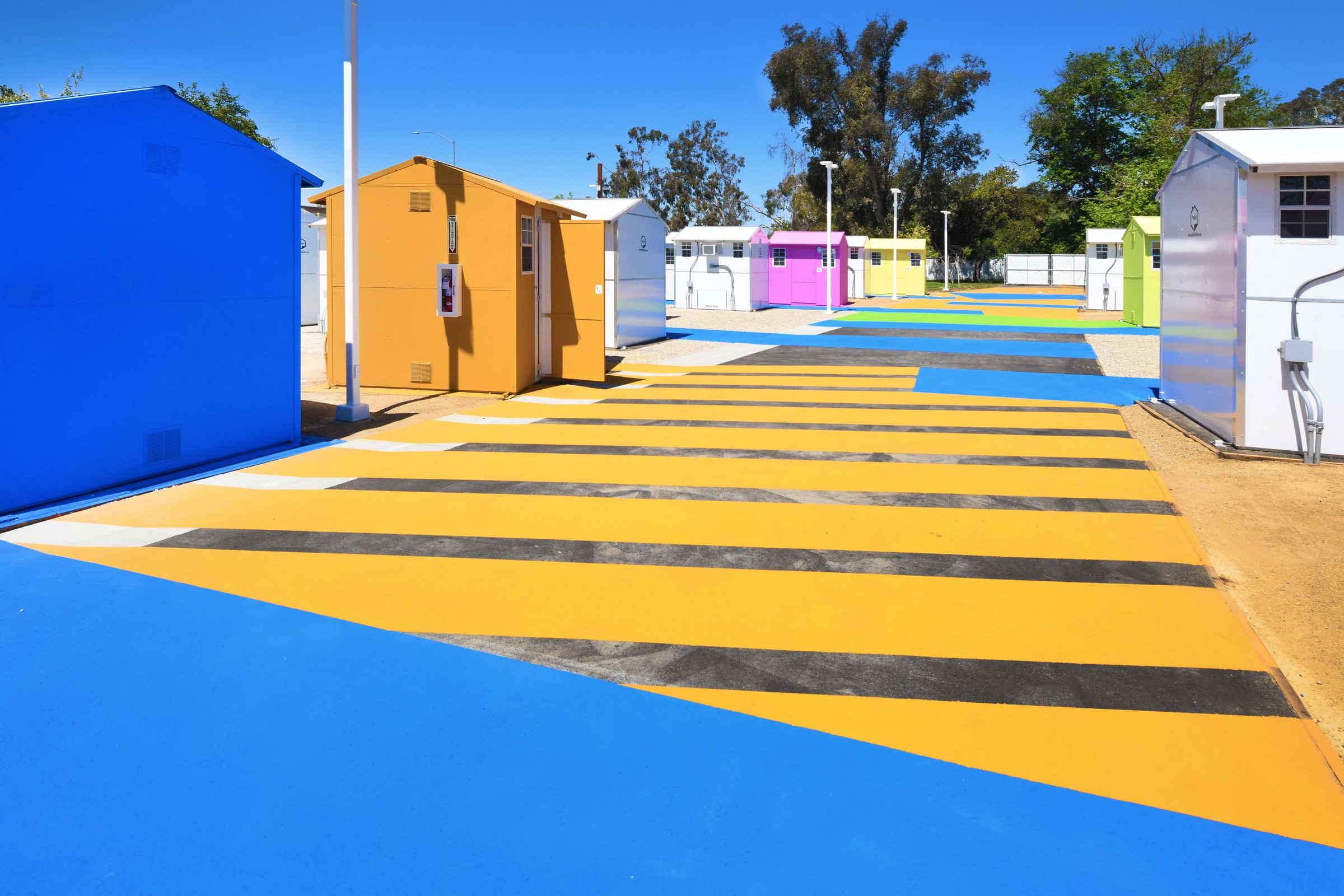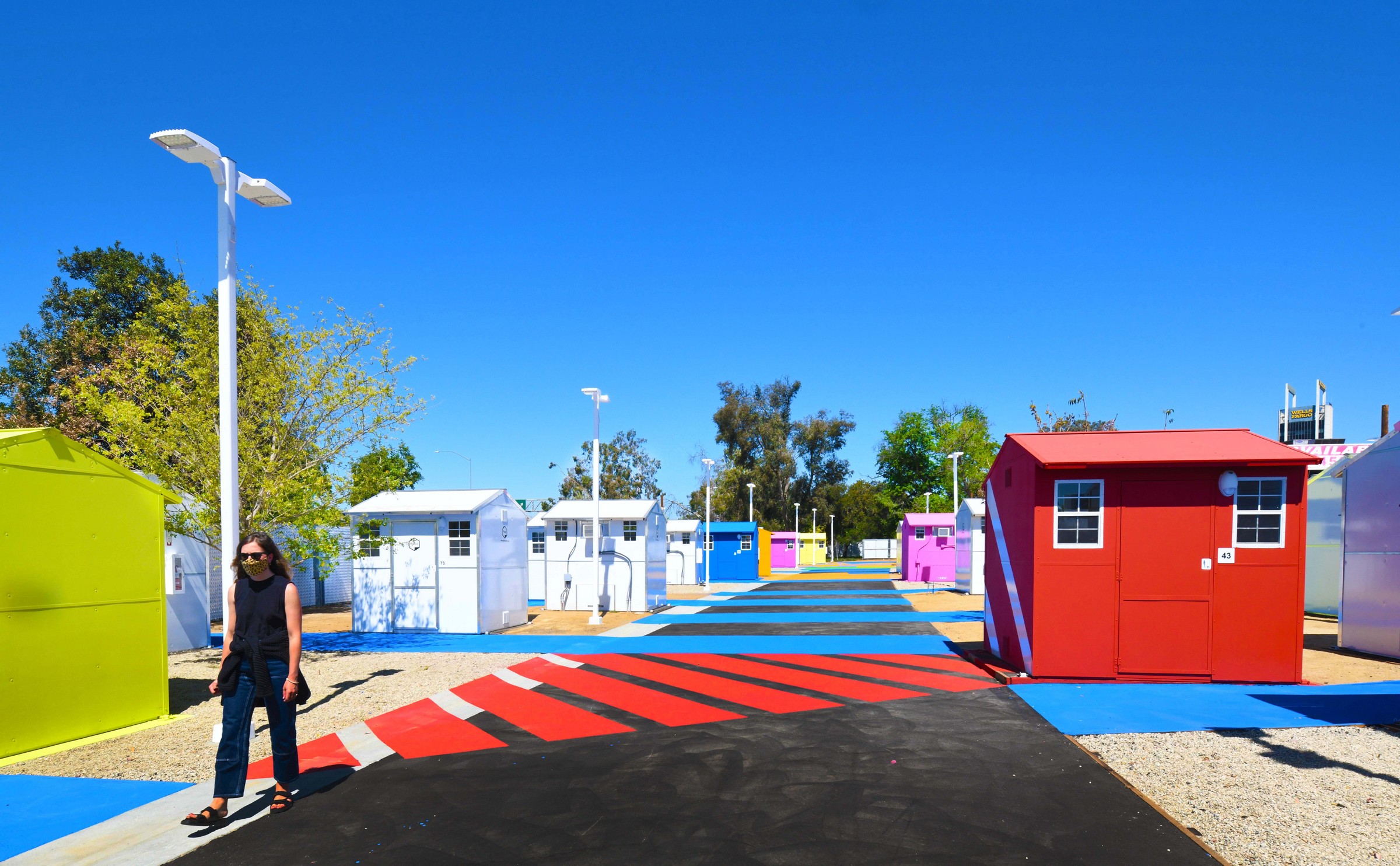The Second Lehrer Architects-designed Tiny Home Village Opens to Residents this Week. More than Twice the Size of the Previous Site, it is the First Large-Scale Deployment of this Experimental Solution to the City’s Housing Crisis
The Alexandria Park Tiny Home Village, designed by Lehrer Architects LA and the City’s architects and engineers in the Bureau of Engineering, opens to residents this week in North Hollywood. The project quickly follows the team’s first collaboration on this prototype Tiny Home format – the Chandler Boulevard Tiny Home Village – that opened in February 2021. More than twice the size of the initial project, the opening of Alexandria marks the first large-scale deployment of this experimental solution to the homelessness crisis, housing up to 200 residents in 103 1 or 2-person units. Working in conjunction with multiple city agencies led directly by the Bureau of Engineering and Ford Construction, Lehrer Architects LA created a vibrant and complex neighborhood, complete with a main street, individual village boulevards and communal formal and semi-formal outdoor spaces, all the while incorporating the natural features of the surrounding parkland and applying modernist paint accents to implement a plan of spatial character that is both a visual and logistical expression of village and reinforced the Bureau of Engineering’s community-making objectives for the site.

Unlike the Chandler Boulevard Tiny Home Village which was set in a busy urban area, the Alexandria Park Village is within the boundaries of an existing city park, in an edge space near the 170 freeway that was otherwise unused and hard to reach. Lehrer Architect’s long-standing philosophy of “no throwaway spaces” aligns with the city’s mission to seek out spaces that would be passed over by other developers for their size, shape or lack of existing infrastructure, and transform them into functional land for use in the city’s ongoing effort to create more transitions to housing for the unhoused. Finding creativity in constraint – the Alexandria site is another long, thin oddly-shaped lot – Lehrer Architects LA and the City saw a source of experiential and visual richness, enabling them to create a bigger and more elaborate community for residents. The 8×8’ Tiny Homes, designed by Pallet in Washington State, are swift to assemble and provide self-contained, conditioned space for each resident that can, crucially, be locked by the occupant for a greater sense of autonomy and privacy on the road to permanent housing. In addition to the individual home units, the project presents a streamlined and efficient arrangement of prefabricated modular units to create collective dining and gathering space, pet play areas, showers, restrooms, laundry, pest control, secure storage for incoming residents’ personal possessions, and assistance with accessing City services.

Another project designed and built in record time, it was completed two weeks shy of its 15-week construction duration with Ford EC, all players contributed to the unprecedented levels of collaboration between the City, its contractor and the service provider. The previous project offered many lessons for all involved that were applied to Alexandria:
“Each component (tiny home, admin trailers, hygiene units, etc.) has exact technical requirements. Being already familiar with these requirements enabled us to solve problems quickly and focus on making the Village an attractive and welcoming community,” says Lehrer Architects LA Partner, Nerin Kadribegovic.

The layout leveraged the parkscape setting, working around both newly planted and established trees as well as expanding the proposed boundaries to incorporate more of the park and two beautiful mature oak trees into the village. They zigzagged the fencing to further blur the boundary between the park and the community, “This way residents do not have to exit the village to enjoy the park and the natural shade canopy,” adds Kadribegovic. In addition to mandated eating areas, they carefully orchestrated a series of small and large gathering spaces, anchored by existing trees, to provide each village “neighborhood” with a place to meet formally or informally. These spaces can organically evolve as the community develops and serve to provide an even greater sense of “home”.
Building on the primary colors of the Chandler Boulevard Project they were able to expand the paving color palette as they had time to build a relationship with the manufacturer and have introduced new tones to the houses themselves to further differentiate homes and add another layer of visual interest. They used a cinematic design approach due to the attenuated geometry of the site, rolling a 3D camera down the “Main Street” of their architectural model and strategically picking which homes to paint to ensure there is a colorful visual offset at every step as you move through the community. They also introduced permeable pea gravel to the palette to help distinguish various village “neighborhoods” whilst being mindful of the environmental impact of the development. Design need not be expensive to create an impact with seemingly pedestrian elements like the gray asphalt flooring transformed into geometric patterns using strategically deployed stripes of color along the floor. In addition, inexpensive vinyl strips were used in the perimeter chain link fencing to add a unifying color and the appropriate privacy from the surrounding public areas.

“LA is surely among the most vibrant laboratories in the world today to be designing and building projects in —big, small permanent, transitional–to remediate and eliminate homelessness. From design to policy to sweating bureaucratic and regulatory conflicts and challenges, this is an auspicious and unprecedented period of experimentation and idea churn, learning lessons fast and embracing those lessons from one project to the next. It is thrilling to be here using our medium to give, develop and invent form and processes to transform LA into a fully housed city. Making a difference is a joy of citizenship.” – Michael B. Lehrer, Founding Partner, Lehrer Architects LA
This village of homes both supports and enhances its immediate neighborhood by creating a scene of visual excitement in a remote area of the park previously languishing unused, as well as providing a path to permanent housing for local homeless residents. This project represents another lightning-quick, highly collaborative, experimental and efficient solution to LA’s homelessness crisis. Lehrer Architects LA has been driven for more than two decades by the core tenet that “beauty is a rudiment of human dignity” and that creating HOME for someone/anyone/everyone is about providing essential safety, love, agency, autonomy and respect. These projects are a model of how to enhance a community by caring for its most vulnerable residents with dignity through design. Thanks to the collaboration with the City’s architects and engineers, Lehrer Architects LA are close to completion on a third Tiny Home Village Shelter at Sunset and Alvarado on the East Side of the City which will open to residents in May.
“As the City’s lead for the last three years for the design and construction of temporary homeless facilities, the Bureau of Engineering has delivered over 1,600 beds with an additional 470 in construction in a range of project types that have created communities for transitioning to permanent supportive housing. The projects have included facilities with communal sleeping spaces, the restoration of a historic building reconfigured as a shelter, repurposed shipping containers, tiny home communities, and a safe camping site. Our ability to quickly test site layouts, estimate the costs, interface with the service providers, design and construct the infrastructural requirements for the projects, identify and pre-order prefabricated site components, and manage the construction process has been key to the timely delivery of these important projects.” – Gary Lee Moore, City Engineer, City of Los Angeles







4 Comments
healing music
(October 23, 2023 - 2:24 am)healing music
healing music
winter ambience
(January 24, 2024 - 1:44 pm)winter ambience
winter ambience
japanese trap bass
(January 24, 2024 - 5:25 pm)japanese trap bass
japanese trap bass
bossa nova
(February 19, 2024 - 11:31 pm)bossa nova
bossa nova
Comments are closed.